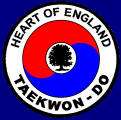 |
Student Theory |
 |
|
Next Page - Beginning Student, Basic Skills, Floor Work - Return to Contents
Taekwon-do has been developed using principles of natural body movement. However, all students are different in that we each have our own physical limitations. We are fortunate that the Human body is very good at adapting to changes in the physical demands placed upon it.
As with all forms of physical activity a student will enjoy their training more if they are able to achieve and maintain a reasonable level of fitness. It is necessary to understand that Taekwon-do is a total body exercise. Taekwon-do training in itself is a very good form of fitness training with the potential to burn up to 800 calories per hour. Many of us live sedentary lifestyles both at work and our leisure time. If you are one of those people whose day to day activities have not involved regular physical activity then it is only natural that you will feel muscles aching following a training session. Students who are new to physical activity should develop their training slowly in the first few weeks, as excessive exercise early on can lead to injuries and discomfort from overworked muscles. If you have any medical conditions which could be affected by your training inform your Instructor who may be able to offer some advice on adapting your training.
Stretching is part of the grading syllabus but more than that is essential to ensure the elasticity in muscles, ligaments and tendons which will prevent injury and allow us to perform techniques correctly. Stretching is something which needs to be built up slowly, regularly and in moderation. There are several forms of stretching but only the two main types of stretching; dynamic and static, are mentioned here. Dynamic stretching involves throwing a limb into a stretch such as performing a leg raise, circling the arms, waist twists, etc. Static stretching is where the limb is extended slowly in such a way as to elongate the muscle group slowly and holding the stretch at maximum extension for a period of around 10 seconds. Examples of static stretching are box splits and front splits. Caution needs to be exercised with any stretching activity as ligaments, tendons and muscles which are not acclimatised to high levels of physical exertion may become strained and even tear. Always listen to your body.
Grading stretching is judged on each individual’s performance in relation to their age, physical fitness and abilities. No one is expected to have the flexibility of an Olympic gymnast. It is however expected that a student will demonstrate improvements in their flexibility at each grading. Grading stretching will be assessed as follows;
White Belt (10th kup) – Front Leg Raises
Yellow Tag (9th kup) – Side Leg Raises
Yellow Belt (8th kup) – Front Splits
Green Tag (7th kup) – Box Splits
Green Belt (6th kup) - Seated Partner Stretching
Blue Tag (5th kup) - Partner Stretch for Front Splits
Blue Belt (4th kup) - Seated Forward Stretch with chest pressed against the knees
Red Tag (3rd kup) and over - Required to demonstrate any of the above stretches as selected by the grading examiner showing improvement from previous assessments
If you have any concerns about your fitness, injuries, etc discuss this with your instructor in the first instance. They have been training for many years and may be able to offer useful advice. If you have an injury but wish to continue training, let your Instructor know so that they can make allowances for any changes in your overall performance. Do not train hard when injured. You are likely to increase the severity of your injury which could lengthen the recovery period and my even lead to a more permanent injury.
Next Page - Beginning Student, Basic Skills, Floor Work - Return to Contents
|
||